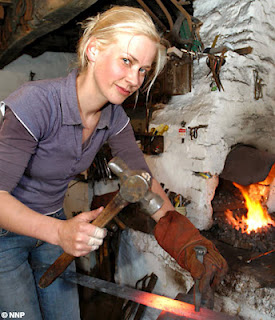Heat conduction welding
In heat conduction welding, the laser beam melts the mating parts along a common joint. The molten materials flow together and solidify to form the weld.
In heat conduction welding, the surface is melted.
Heat conduction welding is used to join thin-wall parts. One example of this are corner welds on the visible surfaces of device housings. Other applications can be found in electronics. The laser produces a smooth, rounded seam that does not require any extra grinding or finishing. Pulsed or continuous wave solid-state lasers are used in such applications. In heat conduction welding, energy is coupled into the workpiece solely through heat conduction. For this reason, the weld depth ranges from only a few tenths of a millimeter to 1 millimeter. The heat conductivity of the material limits the maximum weld depth. The width of the weld is always greater than its depth. If the heat is not able to dissipate quickly enough, the processing temperature rises above the vaporization temperature. Metal vapor forms, the welding depth increases sharply, and the process turns into deep penetration welding.
Minggu, 26 Agustus 2012
Minggu, 19 Agustus 2012
Building shapes out of powder and wire
Building shapes out of powder and wire
Deposition welding is a generating process that is applied for surface finishing as well as repairing or modifying existing components. Depending on the task at hand, either manual or automated laser deposition welding is used.
Manual laser deposition welding: the laser beam melts the filler wire and deposits material on the workpiece surface.
Manual laser deposition welding: the laser beam melts the filler wire and deposits material on the workpiece surface.
Manual laser deposition welding
In the case of manual deposition welding, the welder guides the filler material "by hand" to the area to be welded. A thin wire with a diameter between 0.15 and 0.6 millimeters is primarily used as filler material in this process. The laser beam melts the wire. The molten material forms a strong bond with the substrate, which is also melted, and then solidifies, leaving behind a small raised area. The welder continues in this fashion, spot by spot, line by line, and layer by layer, until the desired shape is achieved. Argon shields the work process from the ambient air. Finally, the part is restored to its original shape by grinding, lathing, milling, EDM etc.
When coating the surface, several powder coatings are either melted onto one another or next to one another, as required. The individual welding paths must precisely overlap in order to achieve a texture that is free from errors.
When coating the surface, several powder coatings are either melted onto one another or next to one another, as required. The individual welding paths must precisely overlap in order to achieve a texture that is free from errors.
Automated laser deposition welding
In the case of automated deposition welding, the machine guides the filler material to the area to be welded. Although the material can also be a wire, this process primarily uses metal powders. Metal powder is applied in layers to a base material and fused to the base material and is fused to it without pores or cracks. The metal powder forms a high-tensile weld joint with the surface. After cooling, a metal layer develops that can be machined mechanically. A strength of this process is that it can be used to build up a number of similar or differing metal layers.
Deposition welding is a generating process that is applied for surface finishing as well as repairing or modifying existing components. Depending on the task at hand, either manual or automated laser deposition welding is used.
Manual laser deposition welding: the laser beam melts the filler wire and deposits material on the workpiece surface.
Manual laser deposition welding: the laser beam melts the filler wire and deposits material on the workpiece surface.
Manual laser deposition welding
In the case of manual deposition welding, the welder guides the filler material "by hand" to the area to be welded. A thin wire with a diameter between 0.15 and 0.6 millimeters is primarily used as filler material in this process. The laser beam melts the wire. The molten material forms a strong bond with the substrate, which is also melted, and then solidifies, leaving behind a small raised area. The welder continues in this fashion, spot by spot, line by line, and layer by layer, until the desired shape is achieved. Argon shields the work process from the ambient air. Finally, the part is restored to its original shape by grinding, lathing, milling, EDM etc.
When coating the surface, several powder coatings are either melted onto one another or next to one another, as required. The individual welding paths must precisely overlap in order to achieve a texture that is free from errors.
When coating the surface, several powder coatings are either melted onto one another or next to one another, as required. The individual welding paths must precisely overlap in order to achieve a texture that is free from errors.
Automated laser deposition welding
In the case of automated deposition welding, the machine guides the filler material to the area to be welded. Although the material can also be a wire, this process primarily uses metal powders. Metal powder is applied in layers to a base material and fused to the base material and is fused to it without pores or cracks. The metal powder forms a high-tensile weld joint with the surface. After cooling, a metal layer develops that can be machined mechanically. A strength of this process is that it can be used to build up a number of similar or differing metal layers.
Langganan:
Postingan (Atom)

